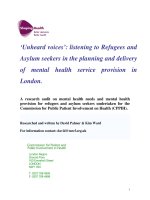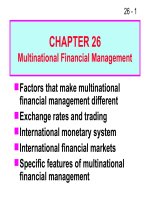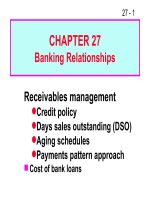FM11 Ch 14 Financial Planning and Forecasting Pro Forma Financial Statements
Bạn đang xem bản rút gọn của tài liệu. Xem và tải ngay bản đầy đủ của tài liệu tại đây (110.27 KB, 39 trang )
14 - 1
CHAPTER 14
Financial Planning and Forecasting
Pro Forma Financial Statements
Financial planning
Additional Funds Needed (AFN) formula
Pro forma financial statements
Sales forecasts
Percent of sales method
14 - 2
Financial Planning and
Pro Forma Statements
Three important uses:
Forecast the amount of external
financing that will be required
Evaluate the impact that changes
in the operating plan have on the
value of the firm
Set appropriate targets for
compensation plans
14 - 3
Steps in Financial Forecasting
Forecast sales
Project the assets needed to support sales
Project internally generated funds
Project outside funds needed
Decide how to raise funds
See effects of plan on ratios and stock price
14 - 4
2004 Balance Sheet
(Millions of $)
Cash & sec. $ 20 Accts. pay. &
accruals $ 100
Accounts rec. 240 Notes payable
100
Inventories 240 Total CL $ 200
Total CA $ 500 L-T debt 100
Common stk 500
Net fixed
assets
Retained
earnings 200
Total assets $1,000 Total claims $1,000
500
14 - 5
2004 Income Statement
(Millions of $)
Sales
$2,000.00
Less: COGS (60%)
1,200.00
SGA costs
700.00
EBIT $ 100.00
Interest
10.00
EBT $ 90.00
Taxes (40%) 36.00
Net income $ 54.00
Dividends (40%) $21.60
Add’n to RE $32.40
14 - 6
AFN (Additional Funds Needed):
Key Assumptions
Operating at full capacity in 2004.
Each type of asset grows proportionally
with sales.
Payables and accruals grow proportionally
with sales.
2004 profit margin ($54/$2,000 = 2.70%)
and payout (40%) will be maintained.
Sales are expected to increase by $500
million.
14 - 7
Definitions of Variables in AFN
A*/S
0
: assets required to support sales; called capital intensity ratio.
∆S: increase in sales.
L*/S
0
: spontaneous liabilities ratio
M: profit margin (Net income/sales)
RR: retention ratio; percent of net income not paid as dividend.
14 - 8
Assets
Sales
0
1,000
2,000
1,250
2,500
A*/S
0
= $1,000/$2,000 = 0.5
= $1,250/$2,500.
∆ Assets =
(A*/S
0
)∆Sales
= 0.5($500)
= $250.
Assets = 0.5 sales
14 - 9
Assets must increase by $250 million.
What is the AFN, based on the AFN
equation?
AFN = (A*/S
0
)∆S - (L*/S
0
)∆S - M(S
1
)(RR)
= ($1,000/$2,000)($500)
- ($100/$2,000)($500)
- 0.0270($2,500)(1 - 0.4)
= $184.5 million.
14 - 10
How would increases in these items
affect the AFN?
Higher sales:
Increases asset requirements,
increases AFN.
Higher dividend payout ratio:
Reduces funds available internally,
increases AFN.
(More…)
14 - 11
Higher profit margin:
Increases funds available
internally, decreases AFN.
Higher capital intensity ratio, A*/S
0
:
Increases asset requirements,
increases AFN.
Pay suppliers sooner:
Decreases spontaneous liabilities,
increases AFN.
14 - 12
Projecting Pro Forma Statements with
the Percent of Sales Method
Project sales based on forecasted growth rate in sales
Forecast some items as a percent of the forecasted sales
Costs
Cash
Accounts receivable
(More )
14 - 13
Items as percent of sales (Continued )
Inventories
Net fixed assets
Accounts payable and accruals
Choose other items
Debt
Dividend policy (which determines
retained earnings)
Common stock
14 - 14
Sources of Financing Needed to
Support Asset Requirements
Given the previous assumptions and choices, we can estimate:
Required assets to support sales
Specified sources of financing
Additional funds needed (AFN) is:
Required assets minus specified
sources of financing
14 - 15
Implications of AFN
If AFN is positive, then you must secure additional financing.
If AFN is negative, then you have more financing than is needed.
Pay off debt.
Buy back stock.
Buy short-term investments.
14 - 16
How to Forecast Interest Expense
Interest expense is actually based on the daily balance of debt during the
year.
There are three ways to approximate interest expense. Base it on:
Debt at end of year
Debt at beginning of year
Average of beginning and ending
debt
More…
14 - 17
Basing Interest Expense
on Debt at End of Year
Will over-estimate interest expense if debt is added throughout the year
instead of all on January 1.
Causes circularity called financial feedback: more debt causes more
interest, which reduces net income, which reduces retained earnings,
which causes more debt, etc.
More…
14 - 18
Basing Interest Expense
on Debt at Beginning of Year
Will under-estimate interest expense if debt is added throughout the year
instead of all on December 31.
But doesn’t cause problem of circularity.
More…
14 - 19
Basing Interest Expense on Average of
Beginning and Ending Debt
Will accurately estimate the interest payments if debt is added smoothly
throughout the year.
But has problem of circularity.
More…
14 - 20
A Solution that Balances Accuracy and
Complexity
Base interest expense on beginning debt, but use a slightly higher interest
rate.
Easy to implement
Reasonably accurate
See Ch 14 Mini Case Feedback.xls for an example basing interest expense
on average debt.
14 - 21
Percent of Sales: Inputs
COGS/Sales 60% 60%
SGA/Sales 35% 35%
Cash/Sales 1% 1%
Acct. rec./Sales 12% 12%
Inv./Sales 12% 12%
Net FA/Sales 25% 25%
AP & accr./Sales 5% 5%
2004 2005
Actual Proj.
14 - 22
Other Inputs
Percent growth in sales 25%
Growth factor in sales (g) 1.25
Interest rate on debt 10%
Tax rate 40%
Dividend payout rate 40%
14 - 23
2005 Forecasted Income Statement
2004
Factor
2005
1st Pass
Sales $2,000 g=1.25 $2,500.0
Less: COGS Pct=60% 1,500.0
SGA Pct=35% 875.0
EBIT $125.0
Interest
0.1(Debt
04
)
20.0
EBT $105.0
Taxes (40%) 42.0
Net. income $63.0
Div. (40%) $25.2
Add. to RE $37.8
14 - 24
2005 Balance Sheet (Assets)
Forecasted assets are a percent of forecasted sales.
Factor
2005
Cash
Pct= 1%
$25.0
Accts. rec.
Pct=12%
300.0
Pct=12%
300.0
Total CA $625.0
Net FA
Pct=25%
625.0
Total assets $1,250.0
2005 Sales = $2,500
Inventories
14 - 25
2005 Preliminary Balance Sheet (Claims)
*From forecasted income statement.
2004 Factor Without AFN
AP/accruals Pct=5% $125.0
Notes payable 100 100.0
Total CL $225.0
L-T debt 100 100.0
Common stk. 500 500.0
Ret. earnings 200 +37.8* 237.8
Total claims $1,062.8
2005
2005 Sales = $2,500









